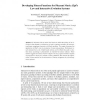Free Online Productivity Tools
i2Speak
i2Symbol
i2OCR
iTex2Img
iWeb2Print
iWeb2Shot
i2Type
iPdf2Split
iPdf2Merge
i2Bopomofo
i2Arabic
i2Style
i2Image
i2PDF
iLatex2Rtf
Sci2ools
EVOW
2005
Springer
2005
Springer
Developing Fitness Functions for Pleasant Music: Zipf's Law and Interactive Evolution Systems
Abstract. In domains such as music and visual art, where the quality of an individual often depends on subjective or hard to express concepts, the automating fitness assignment becomes a difficult problem. This paper discusses the application of Zipf’s Law in evaluation of music pleasantness. Preliminary results indicate that a set of Zipf-based metrics can be effectively used to classify music according to pleasantness as reported by human subjects. These studies suggest that metrics based on Zipf’s law may capture essential aspects of proportion in music as it relates to music aesthetics. We discuss the significance of these results for the automation of fitness assignment in evolutionary music systems.
| Added | 27 Jun 2010 |
| Updated | 27 Jun 2010 |
| Type | Conference |
| Year | 2005 |
| Where | EVOW |
| Authors | Bill Z. Manaris, Penousal Machado, Clayton McCauley, Juan Romero, Dwight Krehbiel |
Comments (0)

